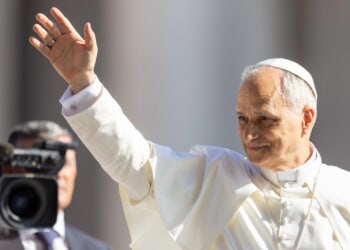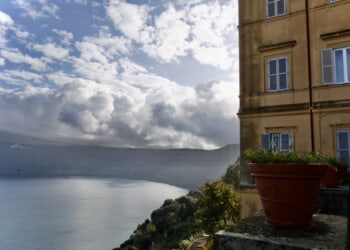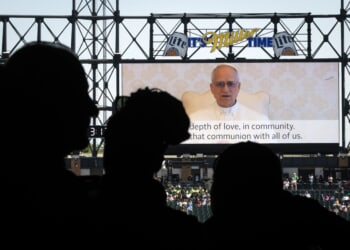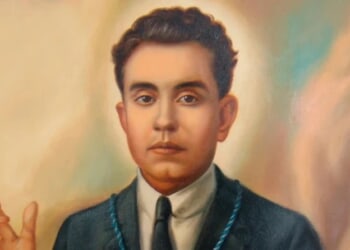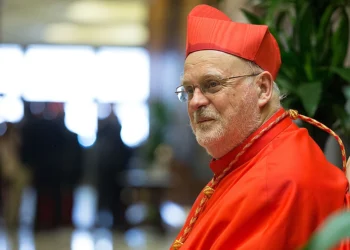Rome Newsroom, Jul 24, 2025 /
12:05 pm
The Italian fashion house Dolce & Gabbana put a spotlight on a new design collection inspired by Catholic liturgical garb in a show on the Sant’Angelo Bridge in Rome last week, prompting a discussion about whether it is appropriate to use Catholic imagery for secular purposes.
The luxury brand called the fashion show, part of three days of showcases in the Eternal City, “an homage to clerical tailoring” with creations inspired by priests’ vestments and other ecclesiastical clothing, including “capes, trains, chasubles, dalmatics, soles, bodices, and bibs.”
Images from the July 15 catwalk depict designs with clear ties to traditional Catholic liturgical clothing, including white, lace shirts similar to a priest’s chasuble or the surplice worn by altar servers. While many of the 106 designs were all white or all black, some feature green, red, and purple — colors used by the Church to denote different liturgical seasons.
Dolce & Gabbana declined to give CNA permission to use images from the event, but the designs can be viewed at its website or on YouTube.
Crosses were heavily featured in the collection, and some models wore or carried what appeared to be Catholic objects such as rosaries, thuribles, and metal incense burners used at Mass and other liturgical celebrations.
The runway, lined with movie extras dressed as cardinals, also showcased less clerical- or papal-looking outfits, with white bodices made to look like marble sculptures of St. Peter and St. Paul, inspired by religious art.
“Every creation strikes a perfect balance between solemnity, devotion, discipline, and aesthetic as well as iconographic codes,” according to information from the fashion brand.
This exclusive #DGAltaSartoria lightweight bodice is sculpted like marble to portray the Apostle Saint Peter, guardian of the keys to Heaven and eternal symbol of welcome on Ponte Sant’Angelo. Through a rigorous and exceptional technique, his face, hair, and the sacred keys… pic.twitter.com/NBvlNJXqv9
— Dolce & Gabbana (@dolcegabbana) July 15, 2025
Theology student Nicola Camporiondo was not a fan of the fashion show, which he commented on in an Instagram story for his 12,800 followers.
The 19-year-old from Vicenza in northern Italy told CNA he thought Dolce & Gabbana’s use of ecclesiastical style was a “usurpation” of a spiritual and liturgical heritage for the purpose of entertainment and “a mere commodification of the sacred.”
“After the sacred has always been a monopoly of the religious, now fashion agencies are using it for their own worldly and profane purposes,” he said.
Camporiondo, who also shares Catholic content on TikTok, where he has 160,000 followers, said he hopes the show can prompt a reflection for the Church about how people still find traditional Catholic aesthetics fascinating, even while the number of practicing Catholics in countries such as Italy declines.
For Father Alberto Ravagnani, a 31-year-old priest of the Archdiocese of Milan, the Dolce & Gabbana show also prompted a reflection on the Church’s tradition of beautiful art and vestments, but he told CNA he was “very much in favor, I really liked it, because I actually believe it’s a way they’ve given value to tradition.”
The “Alta Sartoria” show took place on the pedestrian-only Sant’Angelo Bridge, found directly in front of Castel Sant’Angelo, an ancient mausoleum later used as a papal fortress. The monument is connected to the Vatican by a 2,600-foot-long raised corridor. Part of the Dolce & Gabbana show took place with St. Peter’s Basilica in the distant background.
The approximately 40-minute, invitation-only fashion show opened with what appeared to be an enactment of a religious procession, including men dressed like altar boys and carrying candles, incense, and small canopies often used for Eucharistic processions.
(Story continues below)
Subscribe to our daily newsletter
While Ravagnani had not seen footage of that part of the event, he thought if a fashion house could help restore “luster, value, meaning, and allure” to a religious practice in decline — even if only for a moment and in a secular context — it might not be a bad thing.
The young priest, who is one of the most followed Catholic “influencers” in Italy, also asked his 250,000 followers on Instagram to share their thoughts about the Catholic-inspired Dolce & Gabbana show.
He said the vast majority of those who responded were against it. Some considered it an outrage to tradition or even blasphemous, while others associated it “with ostentation and wealth” rather than an image of the Church as poor, humble, and simple — but he disagreed.
“Indeed, when it is said that the Church today should be simple and humble, this is true, but it doesn’t mean it should be sloppy or ugly,” he said. “God gave us art, God gave us hands, God gave us intelligence and the ability to create things. And so this ability of men to create beautiful things is a way to collaborate in God’s work.”
Father Alberto Rocca, a priest of Milan who has collaborated with Dolce & Gabbana and was in attendance at the July 15 show in Rome, told CNA the designers’ use of Catholic symbols “pays homage to [the Catholic] tradition.”
“It would be very reductive to see it only as fashion and not as art,” he added, highlighting the craftsmanship of the brand’s clothing as a skill that has otherwise been all but lost from Italian culture.
As director of the Ambrosian Pinacoteca, a Milan art gallery, Rocca was an adviser for a Dolce & Gabbana exhibit with clothing pieces inspired by some of the museum’s paintings. He is also a member of an expert committee for the Venerable Ambrosian Library, which preserves cultural and religious patrimony.
The priest said designers Domenico Dolce and Stefano Gabbana “have always used certain [religious symbols] because they are part of the Italian context and they are Catholics.”
Dolce & Gabbana declined a request from CNA to comment.
In addition to the show on Sant’Angelo Bridge, the three-day Roma 2025 haute couture event also planned to debut a Dolce & Gabbana jewelry collection in a July 13 show at Villa Adriana, a park at the site of a classical building complex in Tivoli, 18 miles east of downtown Rome, before being rained out.
On July 14, the Roman Forum, with extras dressed as Roman soldiers, was the venue for the unveiling of styles inspired by mythology, Ancient Rome, and Italian 1950s cinema.
The fashion event took place during the run of a Dolce & Gabbana art exhibition, “From the Heart to the Hands,” at the Palazzo Esposizioni in Rome, May 14 to Aug. 13.
The exhibit of one-of-a-kind creations, first mounted in Milan and Paris, features some of the brand’s most admired pieces from designers Domenico Dolce and Stefano Gabbana, who founded the fashion house in 1985.




